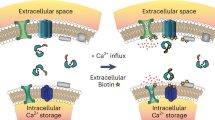Abstract
SUBSTANCE P, an 11 amino acid peptide found in many areas of the nervous system1, has been proposed to be the excitatory transmitter between primary afferents and motoneurons2. A depolarising action of substance P on spinal motoneurons and primary afferents has been demonstrated3–6. But, an initial reduction of response preceding an increased spinal reflex discharge and a reduction of the motoneurone excitatory postsynaptic potential has also been seen in response to substance P (refs 4, 5). In addition, both excitatory and inhibitory effects of substance P on firing of cuneate and cortical Betz cells have been reported7,8. In the hatchetfish Mauthner fibre–giant fibre synapse, substance P has a pronounced presynaptic effect9. We have further investigated the effects of substance P at a synapse in which the electrophysiological characteristics and transmitter are known, the ionic constituents of the Ringer can be manipulated and quantal analysis is possible—the neuromuscular junction of the frog. We report here that substance P has a potent presynaptic effect on transmission at this synapse which is composed of an initial phase in which transmission is depressed, followed by a prolonged period in which excitability and quantal release are increased.
This is a preview of subscription content, access via your institution
Access options
Subscribe to this journal
Receive 51 print issues and online access
$199.00 per year
only $3.90 per issue
Buy this article
- Purchase on Springer Link
- Instant access to full article PDF
Prices may be subject to local taxes which are calculated during checkout
Similar content being viewed by others
References
Leeman, S. E. & Mroz, E. A. Life Sci. 15, 2033–2044 (1975).
Lembeck, F. Arch. exp. Path. Pharmak. 219, 197–213 (1953).
Otsuka, M., Konishi, S. & Takahashi, T. Proc. Japan Acad. 48, 342–346 (1972); 48, 737–752 (1972).
Konishi, S. & Otsuka, M. Brain Res. 65, 397–410 (1974).
Konishi, S. & Otsuka, M. Nature 252, 734–735 (1974).
Nicoll, R. Neurosci. Symp. 1, 99–122 (1976).
Krnjevic, K. & Morris, M. E. Can. J. Physiol. Pharmac. 52, 736–744 (1974).
Phillis, J. W. & Limacker, J. J. Brain Res. 69, 158–163 (1974).
Steinacker, A. & Highstein, S. M. Brain Res. 114, 128–133 (1976).
Krnjevic, K., Puil, E. & Werman, R. Can. J. Physiol. Pharmac. 53, 1214–1218 (1975).
Meech, R. W. & Standen, N. B. J. Physiol., Lond. 249, 211–239 (1975).
Meech, R. A. Comp. Biochem. Physiol. 42 A, 493–499 (1972).
Barrett, E. F. & Barrett, J. N. J. Physiol., Lond. 255, 737–774 (1976).
Katz, B. & Miledi, R. Proc. R. Soc. B 167, 23–28 (1967).
Author information
Authors and Affiliations
Rights and permissions
About this article
Cite this article
STEINACKER, A. Calcium-dependent presynaptic action of substance P at the frog neuromuscular junction. Nature 267, 268–270 (1977). https://doi.org/10.1038/267268a0
Received:
Accepted:
Issue Date:
DOI: https://doi.org/10.1038/267268a0
This article is cited by
-
Postsynaptic effects of substance P in frog neuromuscular junction
Neurophysiology (1992)
-
Actions of polypeptides at the neuromuscular junction
Agents and Actions (1985)
Comments
By submitting a comment you agree to abide by our Terms and Community Guidelines. If you find something abusive or that does not comply with our terms or guidelines please flag it as inappropriate.



